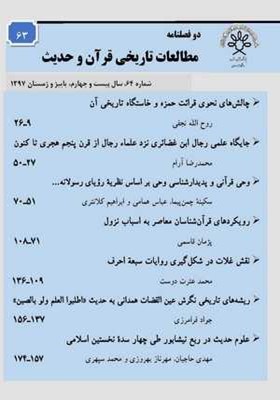نقش غلات در شکلگیری روایات سبعة أحرف
محورهای موضوعی : تاریخ حدیث
1 - استادیار گروه معارف اسلامی، دانشگاه تربیت دبیر شهید رجایی، تهران، ایران.
کلید واژه: اختلاف قرائات, نقد حدیث, تحریف قرآن, احادیث سبعة أحرف, جریان غلات,
چکیده مقاله :
از جملۀ مباحث تخصصی در حوزه علوم و معارف قرآن کریم، نظریه نزول چندگانه قرآن کریم بر مبنای روایات سبعة أحرف است. گذشته از شناسایی زمینه صدور این روایات از پیامبر اکرم (ص)، آنچه در این میان حائز اهمیت بسیار بوده و باعث شده اختلافنظرهای متعددی در میان عالمان شیعه ایجاد شود، وجود روایاتی دالّ بر تأیید این نظریه توسط ائمه صادقین (ع) است. ازآنجاکه این روایات در ظاهر با دیگر روایات ایشان مبنی بر نزول قرآن به حرف واحد مخالفت و تعارض داشته و زمینه طرح بحث از تحریف قرآن در نزد شیعیان را فراهم آورده است، لذا در این پژوهش تلاش شده با استفاده از دو روش نقد سندی و تحلیل تاریخی و توجه به گفتمان حاکم بر عصر ائمه صادقین (ع)، سبب صدور این روایات و ارتباط آن با جریانهای مذهبی ـ اجتماعی صدر اسلام را تبیین نموده و نظر جدیدی در راستای فهم اینگونه روایات بیان کنیم. توجه به جریان غلات، بررسی انگیزه آنان از طرح مبحث اختلاف قرائات قرآنی و چگونگی مواجهه اهلبیت (ع) با این اندیشههای غلط، ازجمله مباحثی است که در این مقاله بدان پرداخته شده.
One of the specialized topics in the field of Quranic sciences and is the theory of the multiple revelation of the Holy Quran based on the Sab'at Aḥruf traditions (which claim that the Quran was revealed in seven different readings). Apart from the necessity to identify the context on which they were issued from the Prophet (peace be upon him), what is of great importance and has caused a great deal of controversy among the Shiite scholars, is the fact that such traditions also exist in Shia works which support this theory, There are some traditions with the same concept coming from Imam Sādiq and Imam Bāqir. Since these narrations seem to contradict the other narrations of Imams about the Qur'an and that it was reveled in a single reading, and considering the fact that such traditions provide the basis for the belief in the distortion of the Qur'an among the Shiites, this study attempts to, by using both criticism and Sandy analysis and considering the historical discourse prevailing in the era of Imams Sādiqain (AS), reveal the reasons for issuing these narratives and their relationship with the socio-religious currents of the early days of Islam and explain a new view to understand such narrations. Considering the activities of the Extremists, their motivation for discussing the Qur'anic controversy, and how Aḥl al-Bayt (AS) was exposed to these false ideas, are among the topics discussed in this article.
_||_


